Poole Ch.P., Jr. Handbook of Superconductivity
Подождите немного. Документ загружается.


536 Chapter 11: Electrical Properties
Hall Effect
The Hall effect employs crossed electric and magnetic fields to provide informa-
tion on the sign, concentration, and mobility of charge carriers. The experimental
arrangement illustrated in Fig. 11.1 shows a magnetic field B 0 applied in the z
direction perpendicular to a slab, and a battery that establishes an electric field Ey
that causes the current I --
JA
of density J -
nev d
to flow along y. The Lorentz
force qv x B 0 on each moving charge q causes a buildup of charge on the sides of
the plate, which produces an electric field
E x
and establishes a Hall voltage
A V x = Exd
perpendicular to the directions of I and B 0. In the superconducting
state a Hall voltage can arise from the transverse electric field
E x
induced by flux
motion. At equilibrium after the buildup of the charge the electric force
qE x
balances the magnetic force qv x B0, and the Hall coefficient RIj, defined as the
ratio
R H = Ex/JB z = 4-1/ne,
(1)
is positive when the majority carriers are holes, as with most cuprates, and
negative for electrons.
Fig. 11.1.
Z Bz
,
-i'---
1
~_~"
Experimental arrangement for Hall effect measurement showing an electrical current I flowing
through a plate of width d and thickness a in the presence of a uniform, transverse magnetic
field B z. The voltage drop V 2 - V 1 along the plate, the drop A Vx across the plate, and the electric
field E x across the plate are indicated. The figure is drawn for the case of negative charge
carriers, that is, electrons. [From Poole
et al.
(1995), p. 18.]
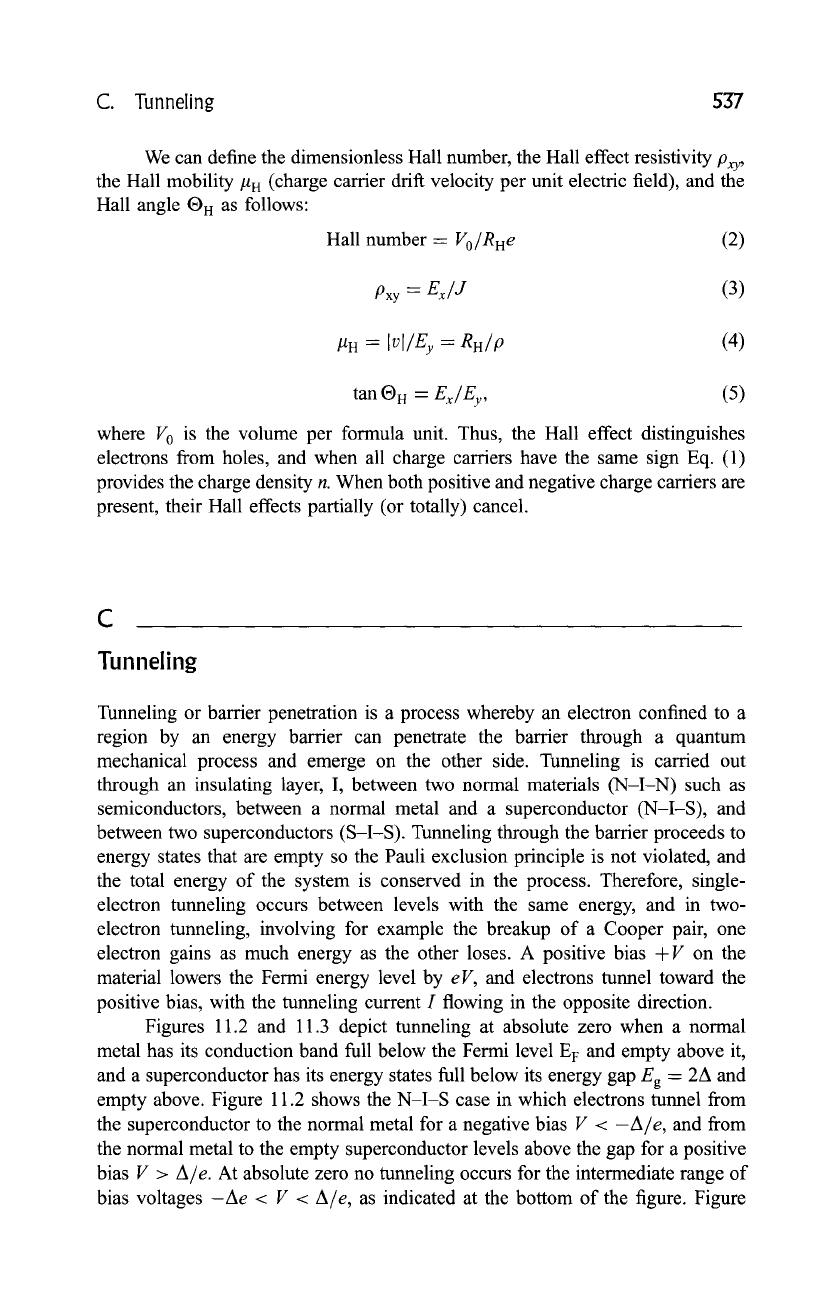
C. Tunneling 537
We can define the dimensionless Hall number, the Hall effect resistivity p~,
the Hall mobility PH (charge carrier drift velocity per unit electric field), and the
Hall angle O H as follows:
Hall number --
Vo/Rl_ie
(2)
pxy =
Ex/J
(3)
la n = [vl/Ey = RI_I/p
(4)
tan | =
Ex/Ey,
(5)
where V 0 is the volume per formula unit. Thus, the Hall effect distinguishes
electrons from holes, and when all charge carriers have the same sign Eq. (1)
provides the charge density n. When both positive and negative charge carriers are
present, their Hall effects partially (or totally) cancel.
C
Tunneling
Tunneling or barrier penetration is a process whereby an electron confined to a
region by an energy barrier can penetrate the barrier through a quantum
mechanical process and emerge on the other side. Tunneling is carried out
through an insulating layer, I, between two normal materials (N-I-N) such as
semiconductors, between a normal metal and a superconductor (N-I-S), and
between two superconductors (S-I-S). Tunneling through the barrier proceeds to
energy states that are empty so the Pauli exclusion principle is not violated, and
the total energy of the system is conserved in the process. Therefore, single-
electron tunneling occurs between levels with the same energy, and in two-
electron tunneling, involving for example the breakup of a Cooper pair, one
electron gains as much energy as the other loses. A positive bias +V on the
material lowers the Fermi energy level by
e V,
and electrons tunnel toward the
positive bias, with the tunneling current I flowing in the opposite direction.
Figures 11.2 and 11.3 depict tunneling at absolute zero when a normal
metal has its conduction band full below the Fermi level E F and empty above it,
and a superconductor has its energy states full below its energy gap Eg = 2A and
empty above. Figure 11.2 shows the N-I-S case in which electrons tunnel from
the superconductor to the normal metal for a negative bias V < -A/e, and from
the normal metal to the empty superconductor levels above the gap for a positive
bias V > A/e. At absolute zero no tunneling occurs for the intermediate range of
bias voltages -Ae < V < A/e, as indicated at the bottom of the figure. Figure

538
Chapter
11:
Electrical Properties
Fig.
11.2.
-V
1~"~ SC
N
(a)
V<- A/e
EF
N
(b)
o
2&
SC
o
SC
(c)
V=O
V>&/e
'1 ' "f
9 ~e i"
.....
J " LVe V
ps /
(g)
Normal metal to superconductor (N-I-S) tunneling at 0 K showing (a) super electron tunneling
(SC =~ N) for V <
-V/e,
(b) the absence of tunneling when the Fermi level is in the gap
(-A/e < V < A/e), and (c) normal electron tunneling (N =~ SC) for V > A/e. Arrows
indicate electron tunneling directions, which are opposite to current flow directions. The
current-voltage characteristic is given in (d). [From Poole
et al.
(1995), p. 407.]
11.3 shows the S-I-S case in which tunneling occurs in one direction for
V <-2A/e, in the reverse direction for V > 2A/e, and at absolute zero it
does not occur at all for the range -2A/e < V < 2A/e. At finite temperatures a
few electrons of a normal metal are found above
E v,
and some electrons of
superconductor are excited to levels above the gap, with the result that a weak
tunneling current flows for the range of biases where it is forbidden at 0 K. If the
gap has a different value for the each material in the S-I-S case, then the weak
tunneling current above absolute zero will exhibit a peak at the bias IA 2 - A 1 I/e,
and a sharp rise at (A 2 + A1)/e, as indicated in Fig. 11.4.
The thickness of the insulating layer is a critical factor in the operation of
the junction. If a superconducting rod is cut at some point, and then joined
through an intervening insulating section, there are three cases to consider: (1)
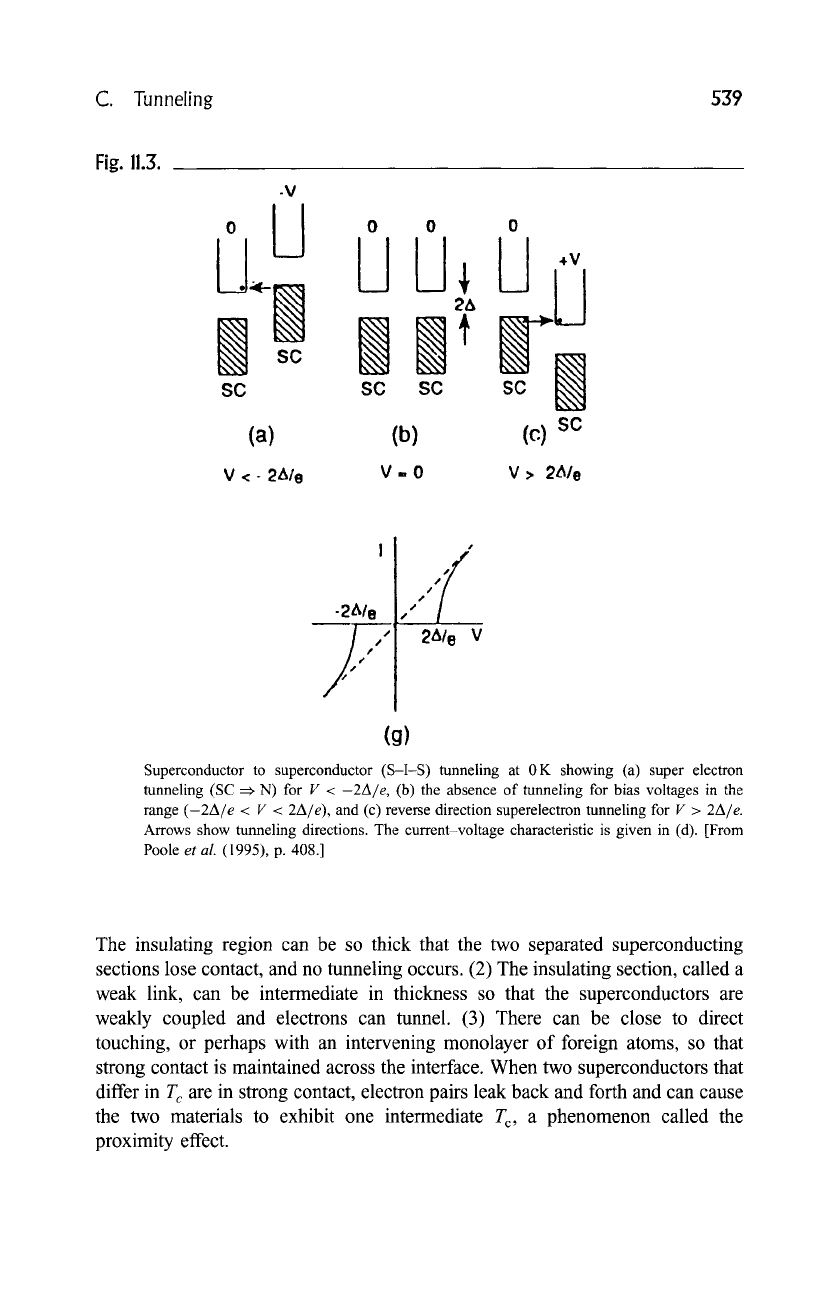
C. Tunneling
539
Fig. 11.3.
-v
SC
SC
0
U
SC
(a) (b)
V <- 261o V = 0
o
2A
SC
0
[_J .v
(c) sc
V > 2Ale
'l " "f
.2A/, /
S "
2AI e
V
t t
(g)
Superconductor to superconductor (S-I-S) tunneling at 0 K showing (a) super electron
tunneling (SC =~ N) for V < --2A/e, (b) the absence of tunneling for bias voltages in the
range (-2A/e < V < 2A/e), and (c) reverse direction superelectron tunneling for V > 2A/e.
Arrows show tunneling directions. The current-voltage characteristic is given in (d). [From
Poole
et al.
(1995), p. 408.]
The insulating region can be so thick that the two separated superconducting
sections lose contact, and no tunneling occurs. (2) The insulating section, called a
weak link, can be intermediate in thickness so that the superconductors are
weakly coupled and electrons can tunnel. (3) There can be close to direct
touching, or perhaps with an intervening monolayer of foreign atoms, so that
strong comact is maintained across the interface. When two superconductors that
differ in T C are in strong contact, electron pairs leak back and forth and can cause
the two materials to exhibit one intermediate To, a phenomenon called the
proximity effect.
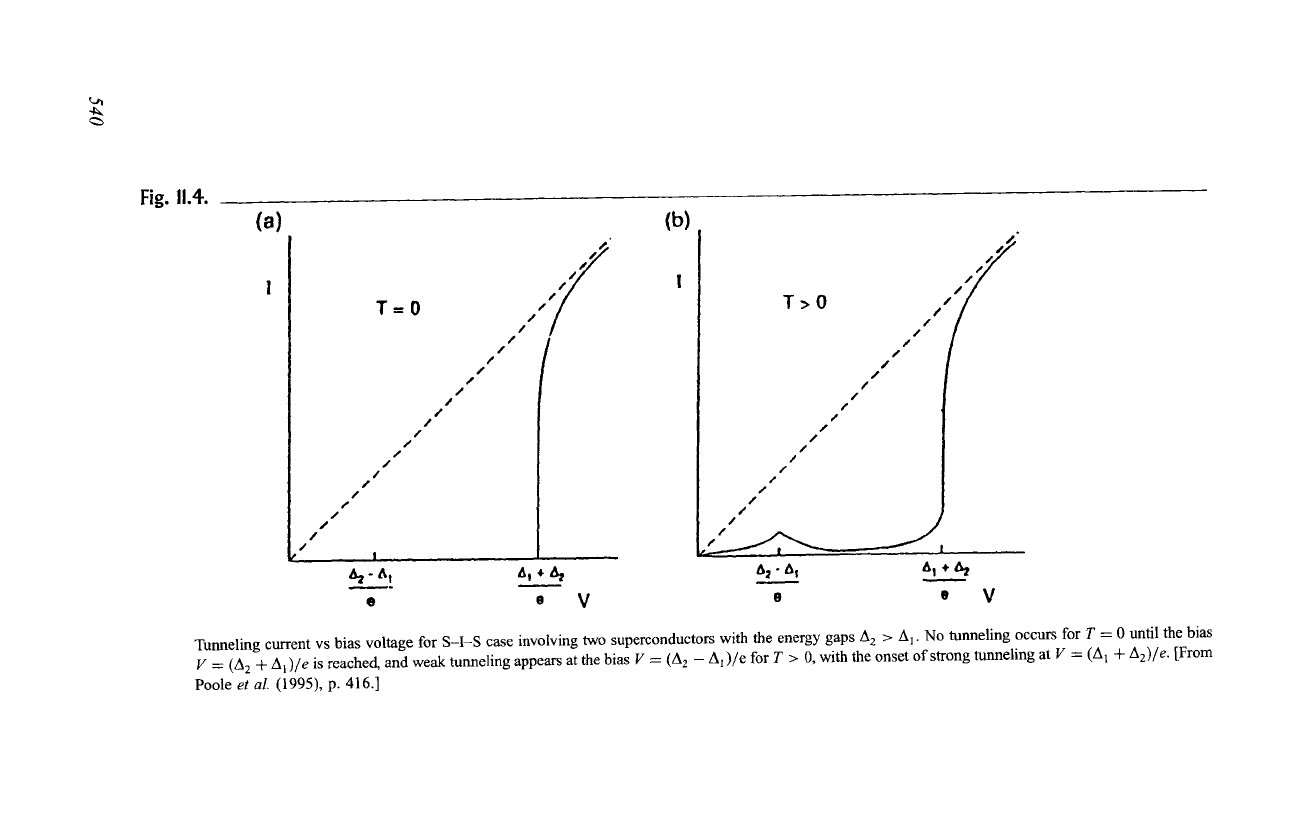
t~
Fig. 11.4.
(a)
/
J
T=O
/
t
/
/
/
1
/
/
t
J
/
/
/
t
/
/
f
f
f
(b)
I
I
T>O
/
/
/
/
/
/
/
t
f
I
,r
I
I
,r
I
/,/,/
I
J
/
|
.....
= .......
.
,
_
~,-~,
~, ./~ ~,-~___~, 5, .~,
9 9 V e 9 V
Tunneling current vs bias voltage for S-I-S case involving two superconductors with the energy gaps A 2 > A 1 . No tunneling occurs for T -- 0 until the bias
V = (A2 + A1)/e is reached, and weak tunneling appears at the bias V = (A 2 - A1)/e for T > 0, with the onset of strong tunneling at V = (A 1 + A2)/e. [From
Poole
et al.
(1995), p. 416.]
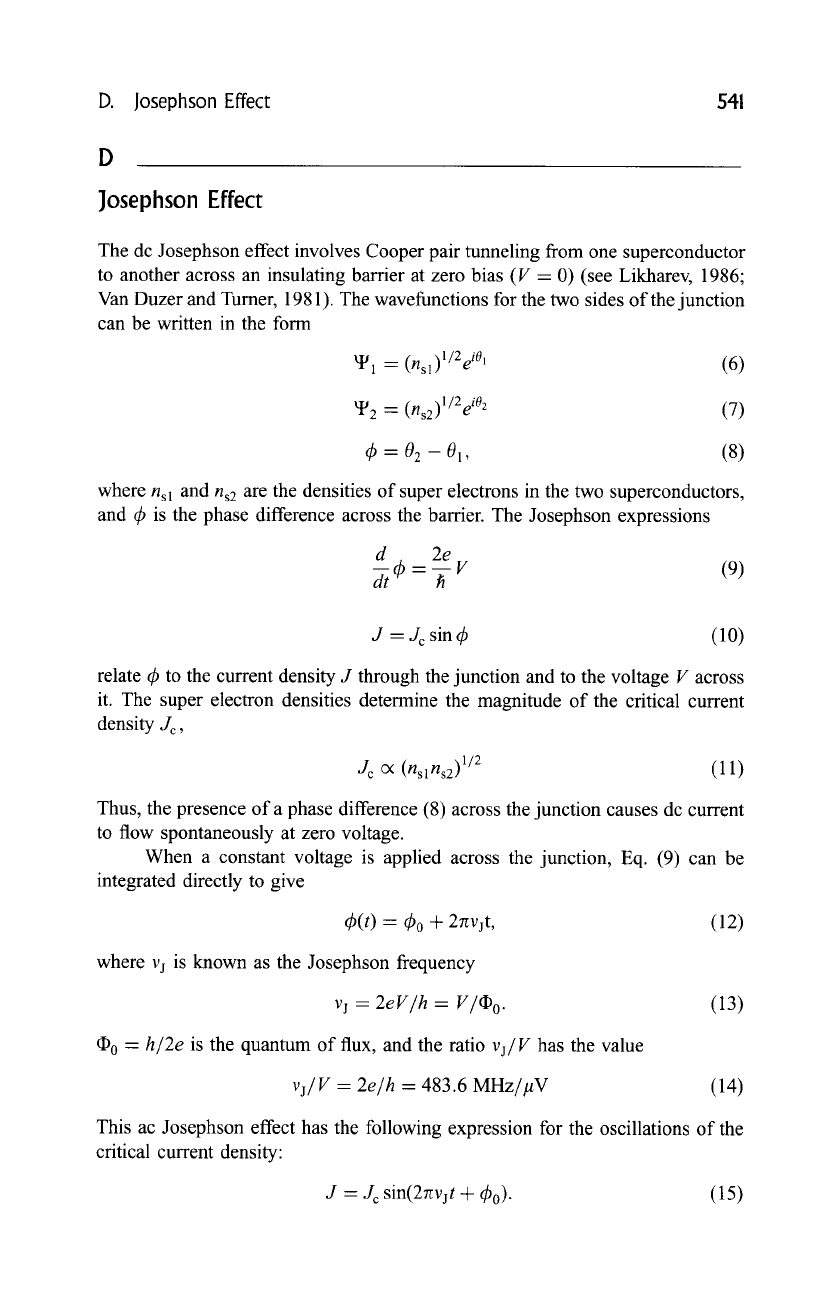
D. ]osephson Effect
541
D
Josephson Effect
The dc Josephson effect involves Cooper pair tunneling from one superconductor
to another across an insulating barrier at zero bias (V = 0) (see Likharev, 1986;
Van Duzer and Turner, 1981). The wavefunctions for the two sides of the junction
can be written in the form
W1 -- (nsl)
1/2ei01
(6)
~2 -- (ns2) 1/2ei02
(7)
4~ = 02 -
01, (8)
where nsl and ns2 are the densities of super electrons in the two superconductors,
and 4) is the phase difference across the barrier. The Josephson expressions
d
2e
dt 05 - ~ V (9)
J = Jc sin ~b (10)
relate ~b to the current density J through the junction and to the voltage V across
it. The super electron densities determine the magnitude of the critical current
density Jc,
Jc cx (nsl ns2) 1/2 (11)
Thus, the presence of a phase difference (8) across the junction causes dc current
to flow spontaneously at zero voltage.
When a constant voltage is applied across the junction, Eq. (9) can be
integrated directly to give
~b(t) -- 4)o + 2rcvjt, (12)
where vj is known as the Josephson frequency
vj -- 2eV/h = V/ap o.
(13)
aP o = h/2e
is the quantum of flux, and the ratio
vj/V
has the value
vj/V = 2e/h
= 483.6 MHz//~V
(14)
This ac Josephson effect has the following expression for the oscillations of the
critical current density:
J -- Jc sin(2rcvjt + ~b0). (15)
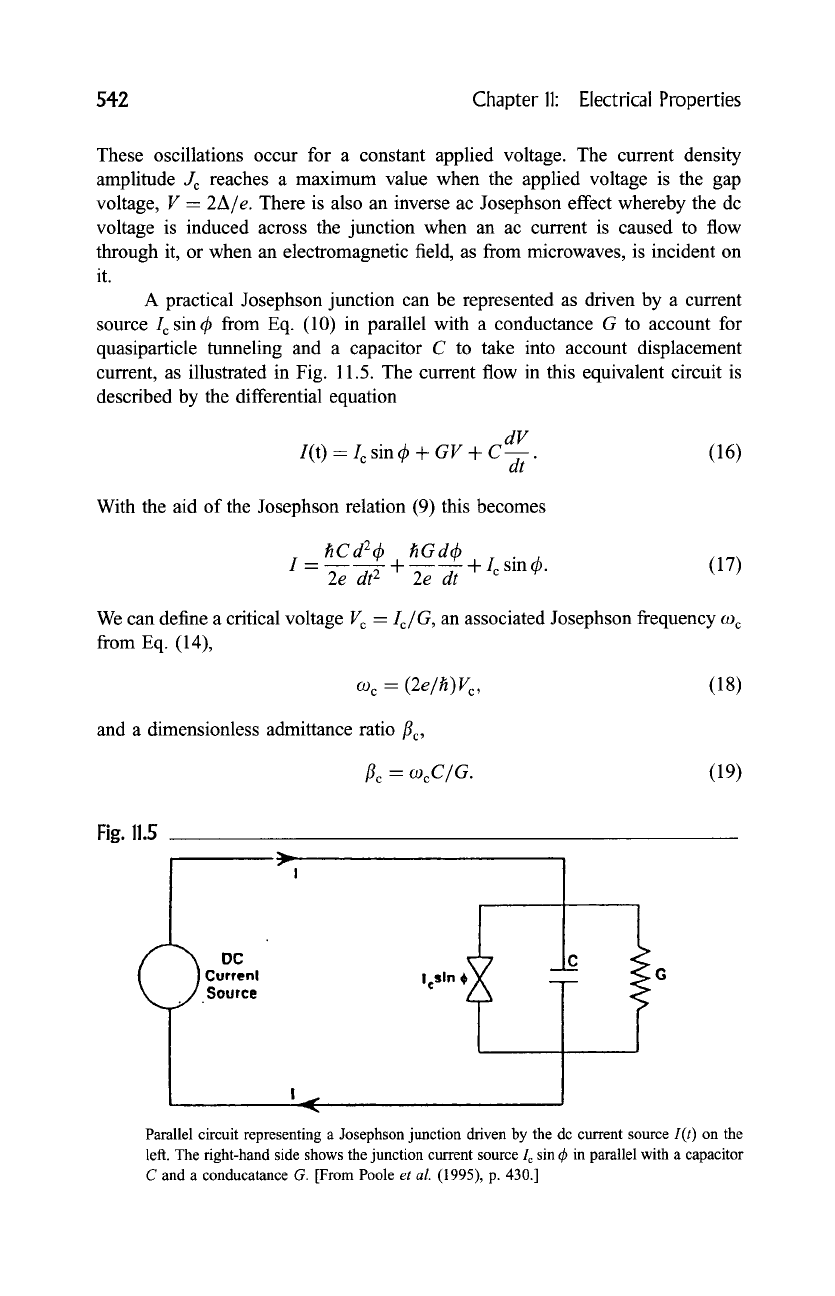
542 Chapter 11" Electrical Properties
These oscillations occur for a constant applied voltage. The current density
amplitude Jc reaches a maximum value when the applied voltage is the gap
voltage, V = 2A/e. There is also an inverse ac Josephson effect whereby the dc
voltage is induced across the junction when an ac current is caused to flow
through it, or when an electromagnetic field, as from microwaves, is incident on
it.
A practical Josephson junction can be represented as driven by a current
source I c sin ~b from Eq. (10) in parallel with a conductance G to account for
quasiparticle tunneling and a capacitor C to take into account displacement
current, as illustrated in Fig. 11.5. The current flow in this equivalent circuit is
described by the differential equation
I(t) - I c sin ~b +
GV + C~
dV
dt "
(16)
With the aid of the Josephson relation (9) this becomes
I - hCdZ~P hGddp
2--e dt----T+-~e---~ +
Ic sin ~b" (17)
We can define a critical voltage Vc -
Ic/G,
an associated Josephson frequency co c
from Eq. (14),
co c -- (2e/h)
V c , (18)
and a dimensionless admittance ratio tic,
fie - ~
(19)
Fig. 11.5
( )coO ,
/.Source
I
I
J
'7
I csln
Parallel circuit representing a Josephson junction driven by the dc current source
I(t)
on the
left. The right-hand side shows the junction current source I c sin ~b in parallel with a capacitor
C and a conducatance G. [From Poole
et al.
(1995), p. 430.]
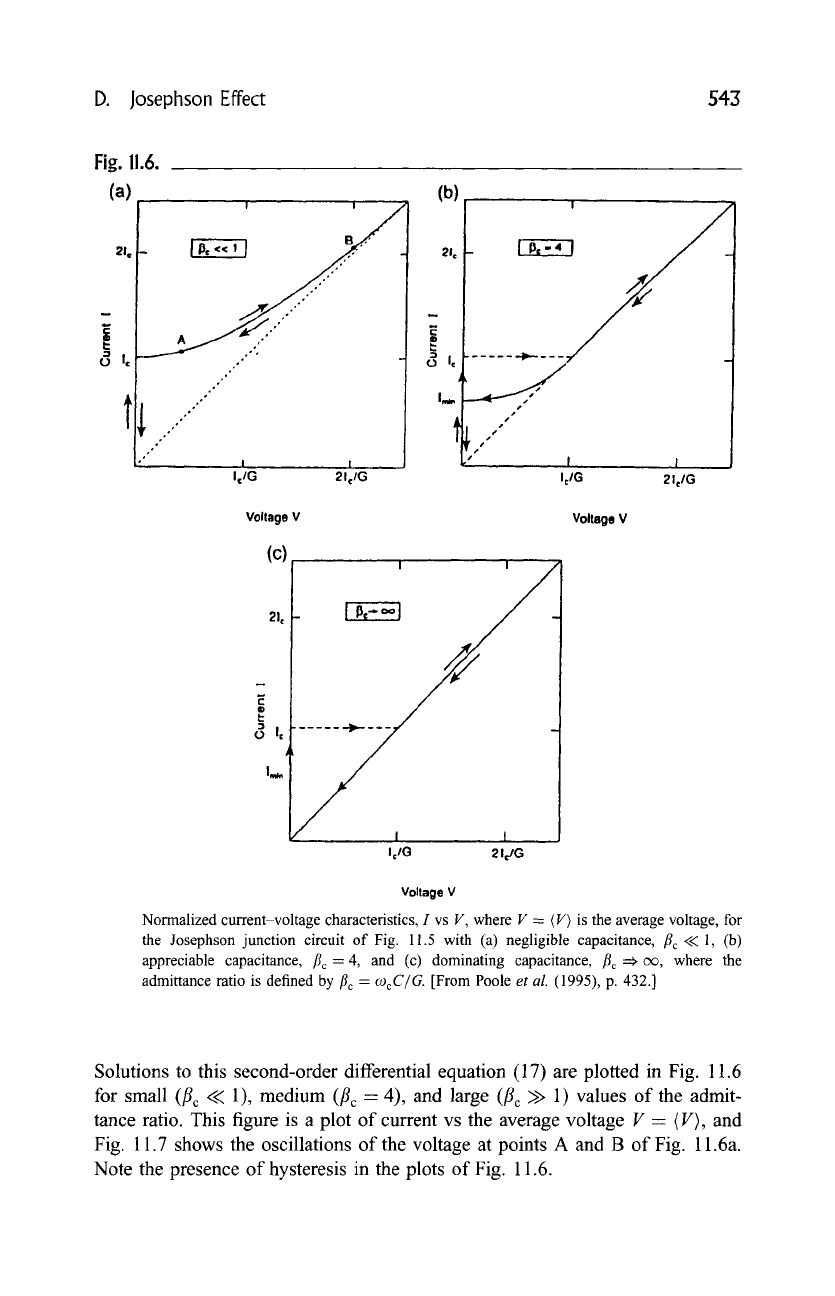
D. Josephson Effect
543
Fig. 11.6.
(a)
21 e
I::
lc
..... ! ' | -
,~
o
l , o~
~
o
9 , I i
.....
Ir 21r
(b).,
21 e
-
/
~ |c -
I I
,,
Ir 21el G
Vollage V
(c)
" i ' I'l /
/-
21, - I PC-" ~176
i
0 !r
I,,,,
" .... l , . . J, I
I = I G 21 r
Voltage V
Vollage V
Normalized current-voltage characteristics, I vs V, where V - (V) is the average voltage, for
the Josephson junction circuit of Fig. 11.5 with (a) negligible capacitance, tic << 1, (b)
appreciable capacitance, /~c = 4, and (c) dominating capacitance, ]~c =~ oo, where the
admittance ratio is defined by/~c =
~
[From Poole
et aL
(1995), p. 432.]
Solutions to this second-order differential equation (17) are plotted in Fig. 11.6
for small (//c << 1), medium (tic = 4), and large (/~c >> 1) values of the admit-
tance ratio. This figure is a plot of current vs the average voltage V = (V), and
Fig. 11.7 shows the oscillations of the voltage at points A and B of Fig. 11.6a.
Note the presence of hysteresis in the plots of Fig. 11.6.
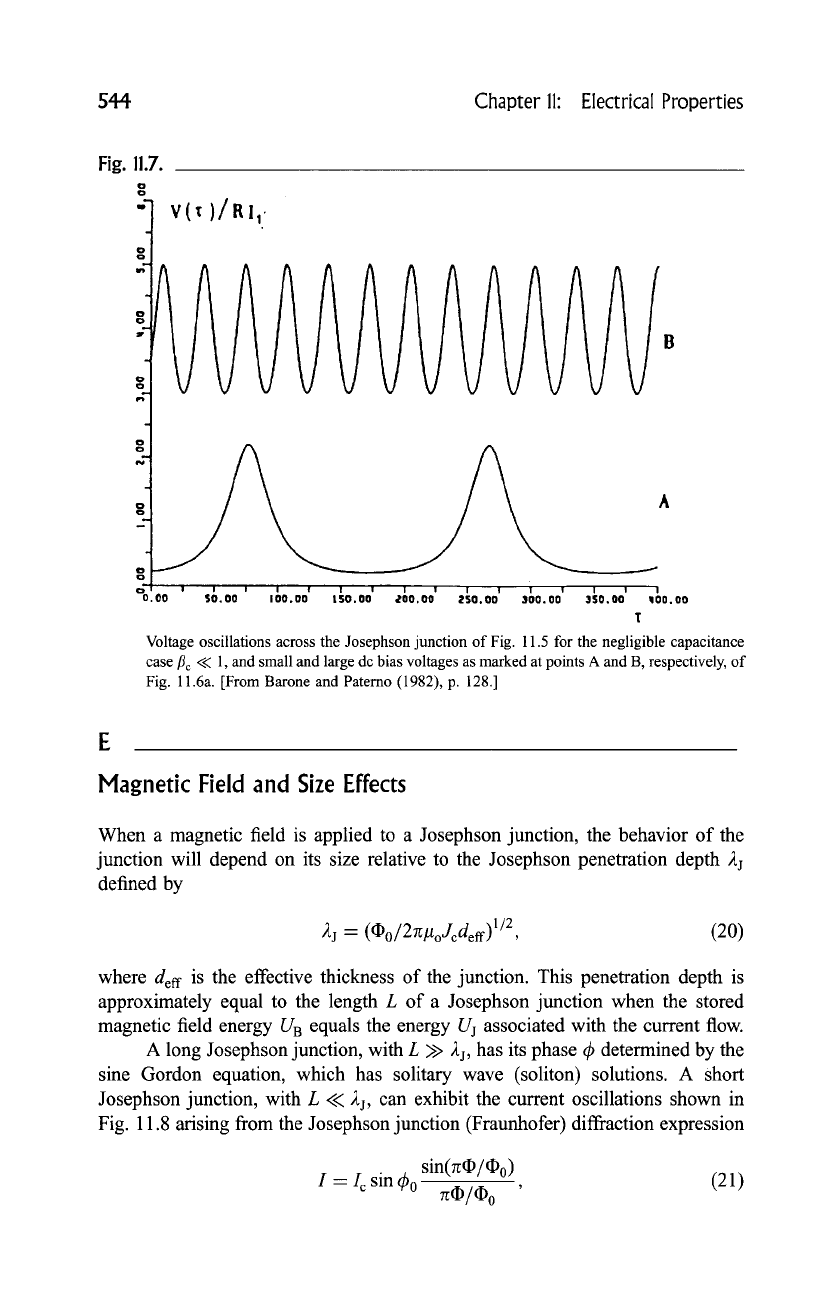
544
Chapter
11:
Electrical Properties
Fig. 11.7.
o
o
it V(T)/Ri,,
I I i f
SO. O0 100. O0
o
o
4~
o
o
o
o
%.00 '
I 1 " I I ' I
ISO,OO ~o0.00 ~ 2sO.OO ~ 3oo.00 ~ 3SO.OO ~ ~oo.oo
T
Voltage oscillations across the Josephson junction of Fig.
11.5
for the negligible capacitance
case
fie << 1,
and small and large dc bias voltages as marked at points A and B, respectively, of
Fig.
11.6a.
[From Barone and Paterno
(1982), p. 128.]
Magnetic Field and Size Effects
When a magnetic field is applied to a Josephson junction, the behavior of the
junction will depend on its size relative to the Josephson penetration depth 2j
defined by
2j --
(Oo/2rC#oJcdeff ) 1/2,
(20)
where def f is the effective thickness of the junction. This penetration depth is
approximately equal to the length L of a Josephson junction when the stored
magnetic field energy UB equals the energy Uj associated with the current flow.
A long Josephson junction, with L >> 2j, has its phase q5 determined by the
sine Gordon equation, which has solitary wave (soliton) solutions. A Short
Josephson junction, with L << 2j, can exhibit the current oscillations shown in
Fig. 11.8 arising from the Josephson junction (Fraunhofer) diffraction expression
I - I c
sin q5 o sin(nO/O~
rc~/~o , (21)
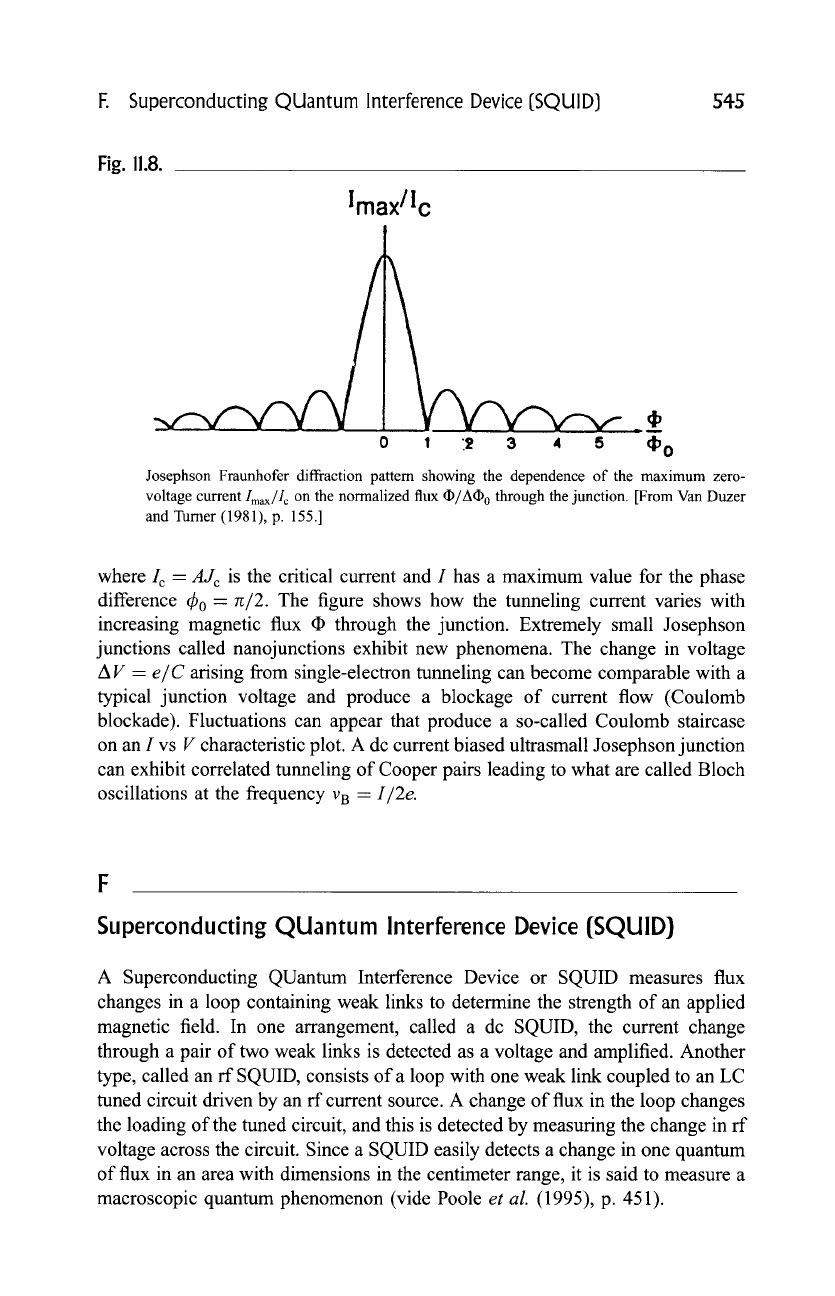
F. Superconducting QUantum Interference Device [SQUID] 545
Fig. U.8.
Imax/l C
_ ;_4
0 1 :2 3 4 5 ~0
Josephson Fraunhofer diffraction pattern showing the dependence of the maximum zero-
voltage current
Imax/I c
on the normalized flux ~/A% through the junction. [From Van Duzer
and Turner (1981), p. 155.]
where I c =
AJ c
is the critical current and I has a maximum value for the phase
difference q50 =
n/2.
The figure shows how the tunneling current varies with
increasing magnetic flux 9 through the junction. Extremely small Josephson
junctions called nanojunctions exhibit new phenomena. The change in voltage
A V = e/C
arising from single-electron tunneling can become comparable with a
typical junction voltage and produce a blockage of current flow (Coulomb
blockade). Fluctuations can appear that produce a so-called Coulomb staircase
on an I vs V characteristic plot. A dc current biased ultrasmall Josephson junction
can exhibit correlated tunneling of Cooper pairs leading to what are called Bloch
oscillations at the frequency v B -
I/2e.
Superconducting QUantum Interference Device (SQUID)
A Superconducting QUantum Interference Device or SQUID measures flux
changes in a loop containing weak links to determine the strength of an applied
magnetic field. In one arrangement, called a dc SQUID, the current change
through a pair of two weak links is detected as a voltage and amplified. Another
type, called an rf SQUID, consists of a loop with one weak link coupled to an LC
tuned circuit driven by an rf current source. A change of flux in the loop changes
the loading of the tuned circuit, and this is detected by measuring the change in rf
voltage across the circuit. Since a SQUID easily detects a change in one quantum
of flux in an area with dimensions in the centimeter range, it is said to measure a
macroscopic quantum phenomenon (vide Poole
et al.
(1995), p. 451).
